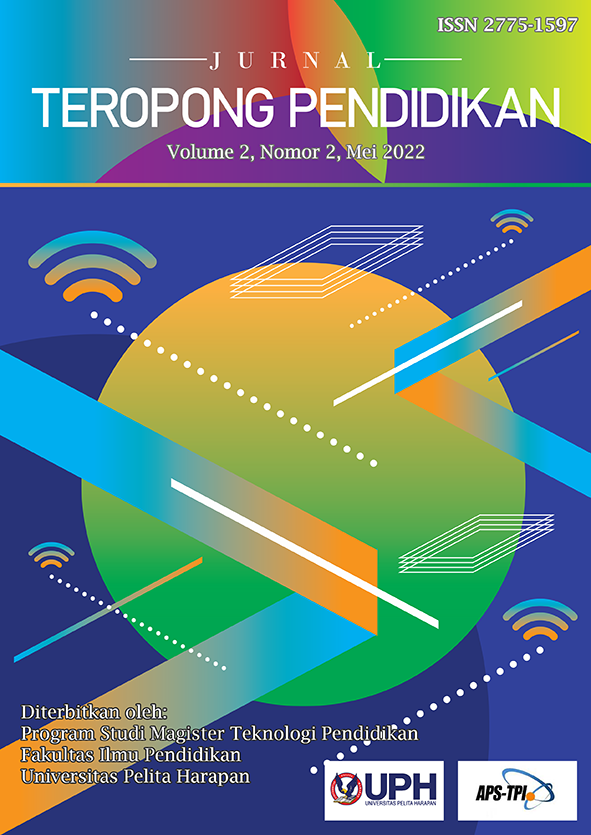Meningkatkan Kosa Kata, Pengucapan Kata, dan Motivasi Belajar Bahasa Inggris Siswa Melalui Penerapan Metode Pembelajaran Total Physical Responses [Increasing Vocabulary, Pronunciation, and motivation to Study English Through Implementation of Total Physical Responses]
DOI:
https://doi.org/10.19166/jtp.v2i2.5695Keywords:
TPR (Total Physical Responses), teaching method, vocabulary, pronunciation, motivation to study EnglishAbstract
Mastering English language is very important because it is the most spoken language in global interaction. In order to master English, early age linguistic education is required. Therefore, the most suitable method used in this research is the Total Physical Responses (TPR), which emphasizes on vocabulary, pronunciation, and motivation to study English. The purposes of this research are: 1) to increase English vocabulary by using the TPR teaching method in Kindergarten A at Ehipassiko School BSD; 2) to increase English pronunciation by using the TPR teaching method in Kindergarten A Ehipassiko School BSD; 3) to increase motivation to study English by using the TPR teaching method in Kindergarten A Ehipassiko School BSD. This research was conducted in Kindergarten A Ehipassiko School BSD with participants of 18 students, consists of 8 boys and 10 girls. The type of this research is pre-experimental research. The results showed an increased vocabulary, pronunciation, and motivation to study English through the method of TPR. It can be seen from the results of the N-Gain, vocabulary 0.755 was in the high category, the pronunciation in the medium category was 0.45 and 0.54 for motivation which is fall into the medium category. Based on the results of this research can be concluded that the teaching of English through the TPR teaching method can increase vocabulary, pronunciation, and motivation to study English.
References
A. M., S. (1988). Interaksi dan motivasi belajar mengajar pedoman bagi guru dan calon guru. Rajawali Press.
A. M., S. (2007). Interaksi dan motivasi belajar mengajar. PT RajaGrafindo Persada.
Arikunto, S. (2002). Metodologi penelitian suatu pendekatan proposal. PT Rineka Cipta.
Arikunto, S. (2008). Penelitian tindakan kelas. Bumi Aksara.
Asmani, J. M. (2013). 7 tips aplikasi PAKEM (Pembelajaran aktif, kreatif, efektif, dan menyenangkan). Diva Press.
Bjorklund, D. F. (2005). Children’s thinking, cognitive development and individual differences. Thomson Wadsworth Learning.
Christina, N. W. (2010). English for kinder garden students. Talenta Media Utama.
Hamalik, O. (2003). Proses belajar mengajar. PT Bumi Aksara.
Handoko, M. (1992). Motivasi daya penggerak tingkah laku. Kanisius.
Kelly, G. J., & Anderson, C. W. (2000). Learning with understanding. Journal of Research in Science Teaching, 37(8), 757-759. https://doi.org/10.1002/1098-2736(200010)37:8%3C757::AID-TEA1%3E3.0.CO;2-E
Lado, R. (1979). Language teaching: A scientific approach. Tata McGraw-Hill.
Mansur. (2005). Pendidikan anak usia dini dalam Islam. Pustaka Pelajar.
Muchtar, S. (1987). Anak dan dunianya. Kencana Media Prananda Group.
Mulyadi. (1991). Psikologi pendidikan. Biro Ilmiah FT. IAIN Sunan Ampel.
Purwanti, E., & Widodo, N. (2005). Perkembangan peserta didik. Universitas Muhammadiyah Malang.
Rahman, H. S. (2002). Konsep dasar pendidikan anak usia dini. Galah.
Sangidu. (2004). Penelitian sastra: Pendekatan, teori, metode, teknik dan kiat. Unit Penerbitan Sastra Asia Barat Fakultas Sastra Universitas Gadjah Mada.
Seefelt, C., & Wasik, B. A. (2008). Pendidikan Anak Usia Dini. Indeks.
Sudjana. (2005). Metode statistika. Tarsito
Sugiyono, (2010). Metode penelitian pendidikan pendekatan kuantitatif, kualitatif, dan R&D. Alfabeta.
Sugiyono. (2009). Metode penelitian pendidikan pendekatan kuantitatif, kualitatif, dan R&D. Alfabeta.
Sugiyono. (2012). Metode penelitian kuantitatif, kualitatif, dan R&D. Alfabeta.
Suhartono. (2005). Pengembangan keterampilan bicara anak usia dini. Depdiknas.
Suprijono, A. (2011). Model-model Pembelajaran. Gramedia Pustaka Jaya.
Tarigan, H. G. (1985). Pengajar Semantik. Angkasa.
Tarigan, H. G. (1993). Pengajaran Kosa Kata. Angkasa.
Tarigan, H. G. (1994). Menulis sebagai suatu keterampilan berbahasa. Angkasa.
Tim Pengembang Ilmu Pendidikan FIP-UPI. (2007). Ilmu dan aplikasi pendidikan. PT Grasindo Intima.
Uno, H. B. (2008). Teori motivasi & pengukurannya: Analisis di bidang pendidikan. Bumi Aksara.
Ur, P. (1996). A course in language teaching. Cambridge University Press.
Zhen, Y. (2011). Using TPE method in teaching English adjective. Kristianstad University Sweden.
Zubaidah, E. (2003). Pengembangan bahasa anak usia dini. Fakultas Ilmu Pendidikan Universitas Negeri Yogyakarta.
Downloads
Published
Issue
Section
License
Authors who publish with this journal agree to the following terms:
1) Authors retain copyright and grant the journal right of first publication with the work simultaneously licensed under a Creative Commons Attribution License (CC-BY-SA 4.0) that allows others to share the work with an acknowledgement of the work's authorship and initial publication in this journal.
2) Authors are able to enter into separate, additional contractual arrangements for the non-exclusive distribution of the journal's published version of the work (e.g., post it to an institutional repository or publish it in a book), with an acknowledgement of its initial publication in this journal.
3) Authors are permitted and encouraged to post their work online (e.g., in institutional repositories or on their website). The final published PDF should be used and bibliographic details that credit the publication in this journal should be included.







